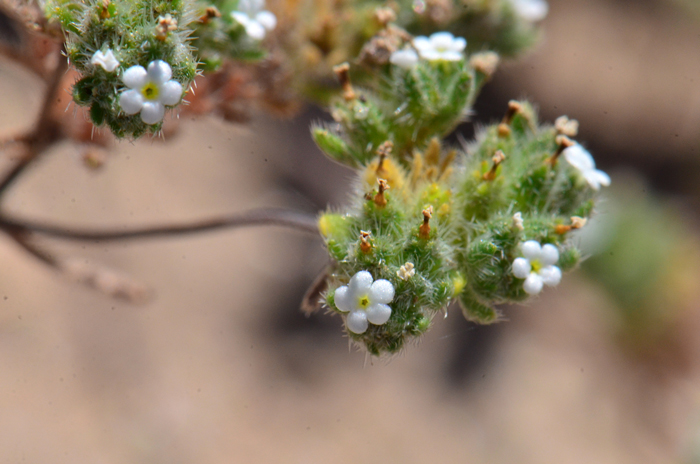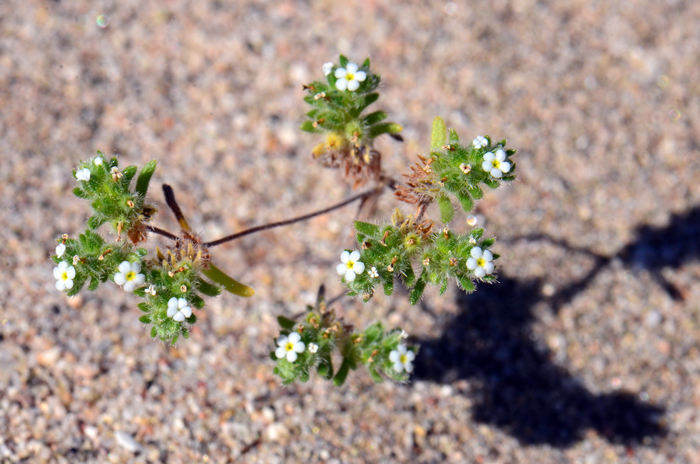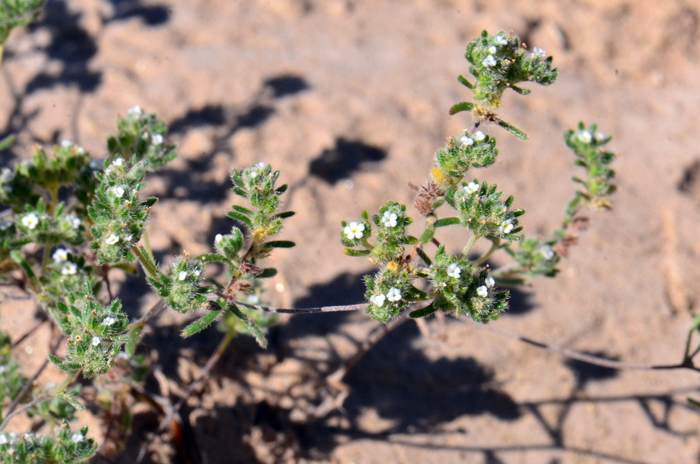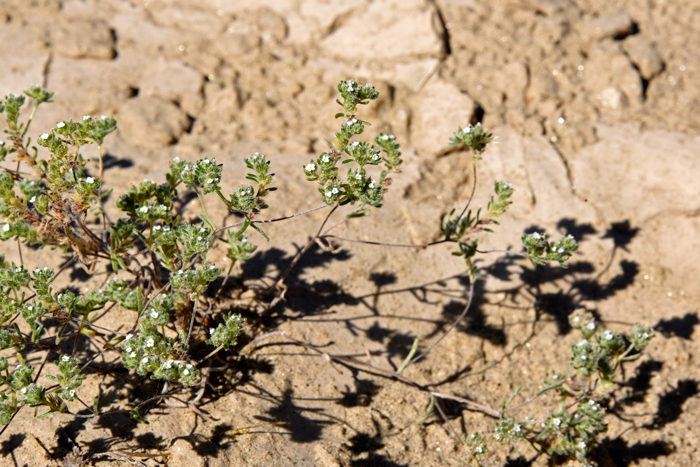Cryptantha micrantha, Redroot Cryptantha




Scientific Name: Cryptantha micrantha
Common Name: Redroot Cryptantha
Also Called: Greater Alley Cat's-Eye, Purpleroot Pick-me-Not, Purple-rooted Forget-me-Not, Redroot Catseye, Redroot Cryptantha (Spanish: Peluda (generic), Nievitas)
Family: Boraginaceae, Forget-Me-Not Family
Synonyms: (Eremocarya lepida, Eremocarya micrantha var. micrantha)
Status: Native
Duration: Annual
Size: Up to 6 inches (15 cm) tall, more or less.
Growth Form: Forb/herb; plants mostly wider than tall; taproots and lower parts of stems with red-purple dye; slender thread-like stems and branches, branching from mostly above; branching ascending or spreading to openly erect; plants covered with small appressed hairs (strigose).
Leaves: Green; leaf blades variable, linear or oblong to oblanceolate; leaves without attaching stalks (sessile); relatively few leaves and scattered along stem; hairs short-bristly; leaves crowded at base near the flowering stalk or inflorescence; leaves quite small, less than 1 mm wide by ⅛ to ⅓ inches (3-8 mm) long.
Flower Color: White, tiny flowers (corollas) funnelform with yellow secondary parts (appendage) in center; (inflorescence) 1 or 2 curving spikes not strongly resembling a scorpions tail (scorpioid) as with other Cryptantha species; fruit a nutlet.
Flowering Season: March to June; in CA var. "micrantha" blooms February to June.
Elevation: 500 to 7,000 feet (150-2,134 m).
Habitat Preferences: Desert flats, washes, sandy to fine-gravelly soils; Creosote bush communities; in California; Creosote Bush Scrub, Yellow Pine Forest, Pinyon-Juniper Woodland, Coastal Sage Scrub.
Recorded Range: Redroot Cryptantha, is found mostly in the southwestern United States with spotty distribution; AZ, CA, NM, NV, OR, TX, UT. In AZ Redroot Cryptantha is scattered throughout the state. This species is also native to Baja California and northwest Mexico.
North America & US County Distribution Map for Cryptantha micrantha.
U.S. Weed Information: No information available.
Invasive/Noxious Weed Information: No information available.
Wetland Indicator: No information available.
Threatened/Endangered Information: No information available.
In the Southwestern United States: Arizona has 37 species of genus, California has 60 species, Nevada has 44 species, New Mexico has 23 species, Texas has 15 species, Utah has 55 species. All data approximate and subject to revision.
The genus Cryptantha was published by Johann Georg Christian Lehmann in 1837.
There are 2 varieties in Redroot Cryptantha, Cryptantha micrantha:
Cryptantha micrantha var. lepida, (CA);
blooms March to August; 1,000 to 9,000 feet (300-2,800 m); habitat: mountain slopes, flats, valleys, granite-based gravelly soils, generally conifer forest, also chaparral, foothill woodland, Joshua-tree woodland;
Cryptantha micrantha var. micrantha, (AZ, CA, NM, NV, OR, TX, UT).
blooms February to June; below than 6,200 feet (1,900 m); habitat: desert flats, washes, sandy to fine-gravelly soils.
Comments: Members of the genus Cryptantha are collectively referred to as Cat’s Eyes or Popcorn Flowers. Cryptantha micrantha is one of over 100 species of Cryptantha found in the United States.
Cryptantha species have typically white flowers in spikes like a scorpions (scorpioid) tail. They are often difficult to identify in the field or lab and a close examination (10x loupe or dissecting scope) of the flowers and the small seeds or nutlets is usually required. Cryptantha micrantha is relatively easy to identify in the field with its red or purplish roots and a somewhat unusually small appearance and few leaves with bare stems.
In Southwest Desert Flora also see Bearded Cryptantha, Cryptantha barbigera, Gander's Cryptantha, Cryptantha ganderi, Narrowstem Cryptantha, Cryptantha gracilis, Panamint Cryptantha, Johnstonella angustifolia, Torrey's Cryptantha, Cryptantha torreyana, and Wingnut Cryptantha, Cryptantha pterocarya.
The species epithet "micrantha" (micran'tha/micran'thum/micran'thus:) means small-flowered.

